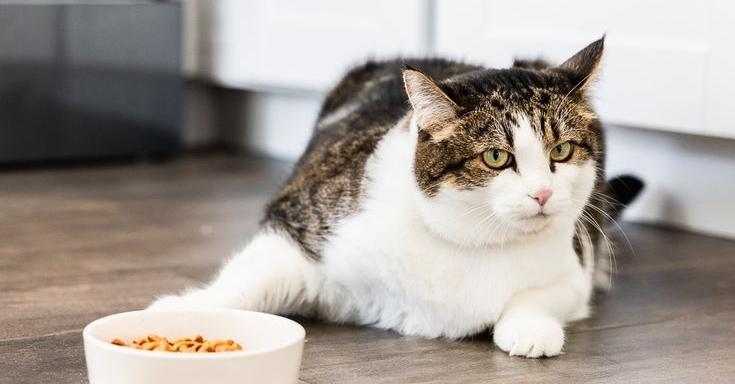If your cat gets enough food each day, it’ll still feel hungry because that’s how they’re wired from the wild. So, giving them food until they’re full usually means giving them too much, except if they’re young kittens.
In nature, cats eat many small meals by hunting and catching prey. But having a bowl of dry food out all day lets them eat a lot without any effort, which can make them gain weight.
Cats who get their food handed to them need less food each day than if they had to hunt for it. As cats get older, they become less active but still want to eat a lot. This can make it tricky to keep them at a healthy weight.
Your cat might have trained you to feed them. They might do things like waking you up in the morning to get fed sooner or running to the kitchen when they hear the fridge because they know that’s where the food is.
A hungry cat can cause trouble by looking for food, being grumpy with other cats, bothering people, or being destructive. While being active is good, it can be annoying for everyone else in the house. But giving in to their demands for food just encourages them to keep acting that way.
You don’t have to give your cat a lot of different types of food. Cats are good at making their owners give them something else if they don’t like what is being offered. Most cats do not need any encouragement to eat.
Canned food is better for cats than dry food because it’s closer to what they would eat in the wild, and it’s also better for their kidneys and urinary system. Most cats need about 4-5 ounces of canned food per day.
Dry food is cheaper but not as good for cats; it is high in calories so they may eat too much and gain weight. Splitting up their dry food into smaller meals throughout the day can help with this problem.
Providing your cat with both canned and dry food can cause them to gain weight since they will consume the two even when they are not hungry. In terms of monitoring their intake, it is difficult to regulate which the kinds of food they eat; therefore, it is preferable to use only one.
Your veterinarian may suggest the amount and type of food that should be given to your feline. It becomes necessary to measure their meals attentively so that there is no overfeeding involved. Regularly weighing them will enable you to keep a record of their weight as well as ensure that they shed pounds at a proper speed.
How Long Can Wet Cat Food Stay Out?
Ideally, wet cat food should not be left out for longer than a few hours. After this time, harmful bacteria may begin to grow and can cause stomach upsets or even make your cat ill.
Keeping Things Fresh for Your Kitty
If your cat does not eat all of its wet food in one go, try giving it smaller portions throughout the day. This will prevent any waste and ensure that each serving is at its freshest.
Understanding Your Cat’s Tastes
There could be several reasons why your furry friend is not interested in wet food. Some cats simply prefer the crunch of dry kibble, while others like their meals warmed up. Watching how they eat can provide some useful clues as to what they enjoy.
What to Do If Your Cat Snubs Wet Food
When a cat rejects its moist food by turning its nose away from it, take action immediately. Consult your veterinarian who will determine if there are any underlying problems and recommend alternative diets or changes in feeding routine as necessary.
Why Cats Bury Their Food
Have you ever wondered why your feline buries its food? It’s an instinctive behavior inherited from their wild ancestors; they used to cache prey items so that other animals couldn’t find them easily among leaves and grasses
